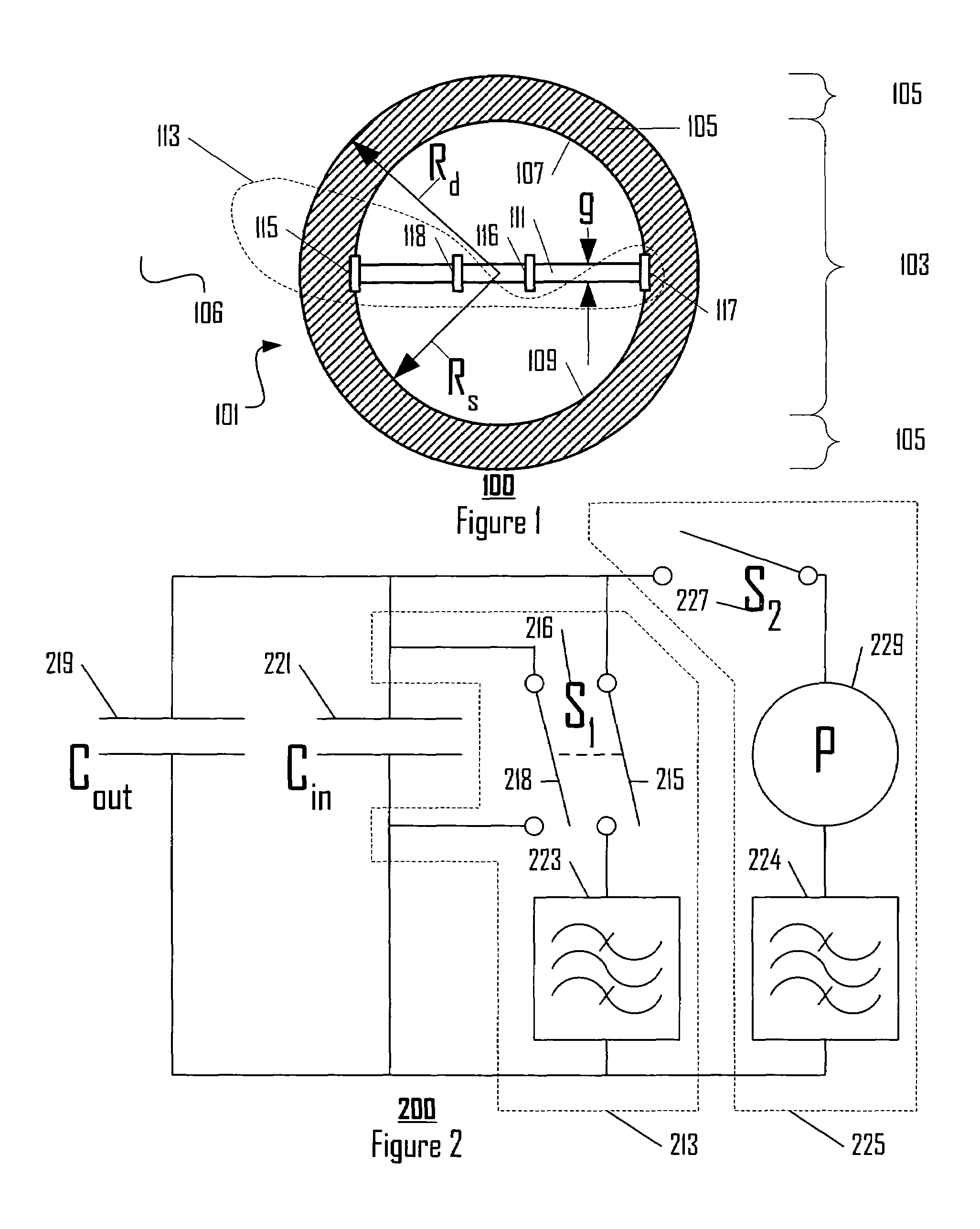Tag-along microsensor device and method
a microsensor and tag technology, applied in the field of tagalong microsensor devices and methods, can solve the problems of inefficiency of existing small vhf/uhf uwb antennas, too large for many potential applications, and inability to meet the needs of large-scale applications,
- Summary
- Abstract
- Description
- Claims
- Application Information
AI Technical Summary
Problems solved by technology
Method used
Image
Examples
first alternate embodiment
[0063]FIG. 5 is a schematic diagram 500 of a first alternate embodiment nano-antenna apparatus 501. First alternate embodiment nano-antenna apparatus 501 comprises a dielectric layer 505, a first conducting surface 507 and a second conducting surface 509. First conducting surface 507 and second conducting surface 509 are separated by a gap region 511. First alternate embodiment nano-antenna apparatus 501 occupies a volume that is substantially similar to a prolate spheroid.
[0064]Although in general an approximate symmetry in relative size is preferred, first conducting surface 507 is much smaller in extent than second conducting surface 509. In this embodiment, first conducting surface 507 is a protuberance on second conducting surface 509. Such an asymmetric form factor is preferred if the frequency content of a desired radiated signal is higher than would otherwise be radiated by a symmetric configuration. Shaping of first conducting surface 507 and second conducting surface 509 a...
second alternate embodiment
[0065]FIG. 6 is a schematic diagram 600 of a second alternate embodiment nano-antenna apparatus 601. Second alternate embodiment nano-antenna apparatus 601 comprises a dielectric layer 605, a first conducting surface 607 and a second conducting surface 609. First conducting surface 607 and second conducting surface 609 are separated by a gap region 611.
[0066]Second alternate embodiment nano-antenna apparatus 601 has an oblate spheroidal form factor. Such a form factor is useful where a predictable device orientation is preferred. For instance, if nano-antenna apparatus 601 were deployed out of an aerial vehicle, nano-antenna apparatus 601 would likely come to rest with short axis 675 in a substantially vertical orientation.
[0067]Further, gap region 611 has a serrated or meandering form factor. The extra length of this serrated or meandering form factor helps concentrate additional electrostatic energy outside nano-antenna apparatus 601, thus making nano-antenna apparatus 601 more ef...
third alternate embodiment
[0068]FIG. 7 is a schematic diagram 700 of a third alternate embodiment nano-antenna apparatus 701. Third alternate embodiment nano-antenna apparatus 701 comprises a dielectric layer 705, a first conducting surface 707 and a second conducting surface 709. A first conducting surface 707 and a second conducting surface 709 are separated by a gap region 711.
[0069]Third alternate embodiment nano-antenna apparatus 701 has an approximately Cartesian rectangular solid form factor, preferred for many consumer devices. Various ratios of height to width to depth may be appropriate for various applications. Third alternate embodiment nano-antenna apparatus 701 may also be more manufacturable.
Preferred Embodiment Tag-Along Microsensor
[0070]FIG. 8 is a cross-section diagram 800 of a preferred embodiment tag-along microsensor 801. Tag-along microsensor 801 includes a means for transmitting signals: a nano-antenna device comprising a first conducting surface 107 and a second conducting surface 109...
PUM
 Login to view more
Login to view more Abstract
Description
Claims
Application Information
 Login to view more
Login to view more - R&D Engineer
- R&D Manager
- IP Professional
- Industry Leading Data Capabilities
- Powerful AI technology
- Patent DNA Extraction
Browse by: Latest US Patents, China's latest patents, Technical Efficacy Thesaurus, Application Domain, Technology Topic.
© 2024 PatSnap. All rights reserved.Legal|Privacy policy|Modern Slavery Act Transparency Statement|Sitemap



